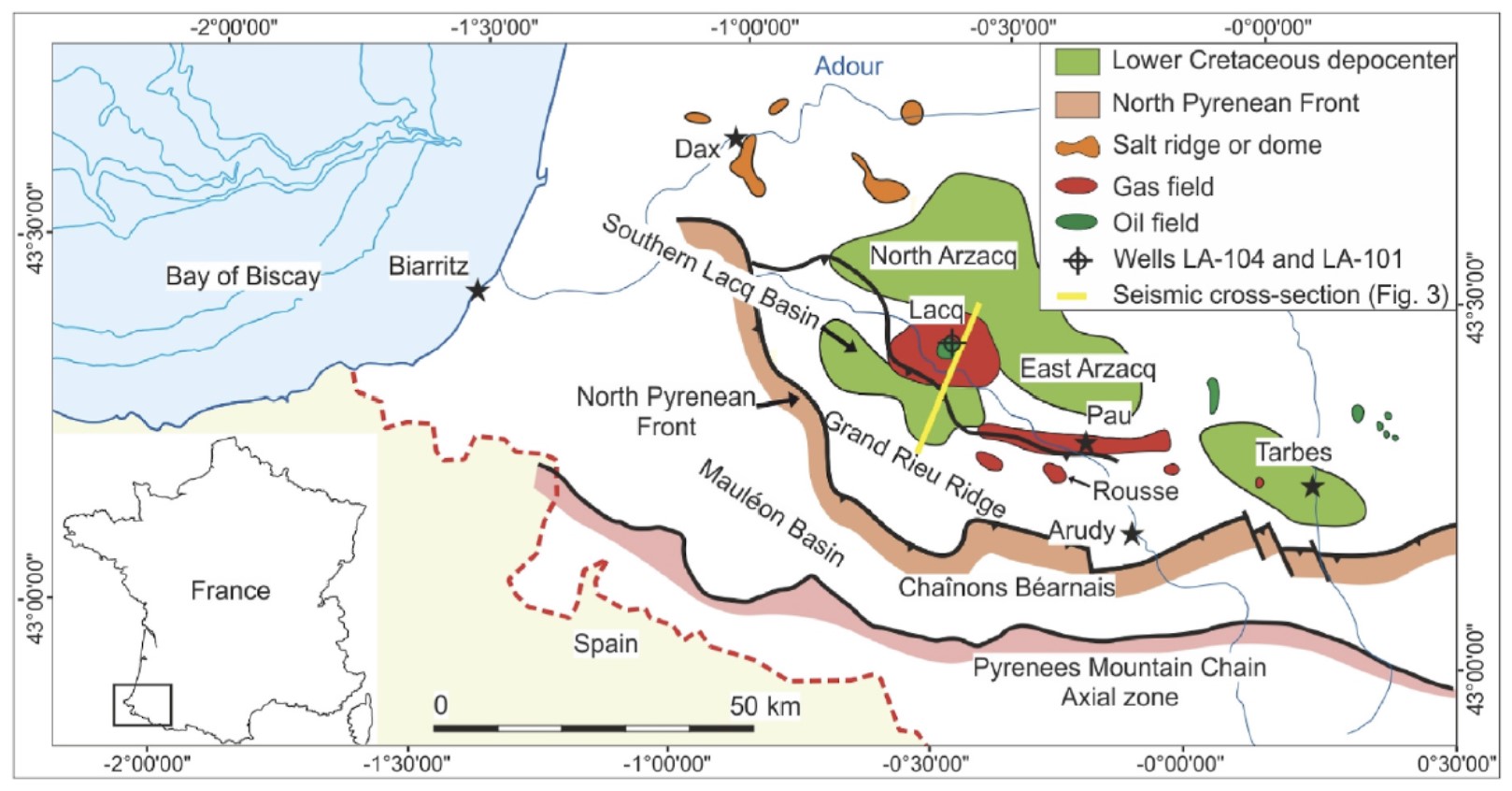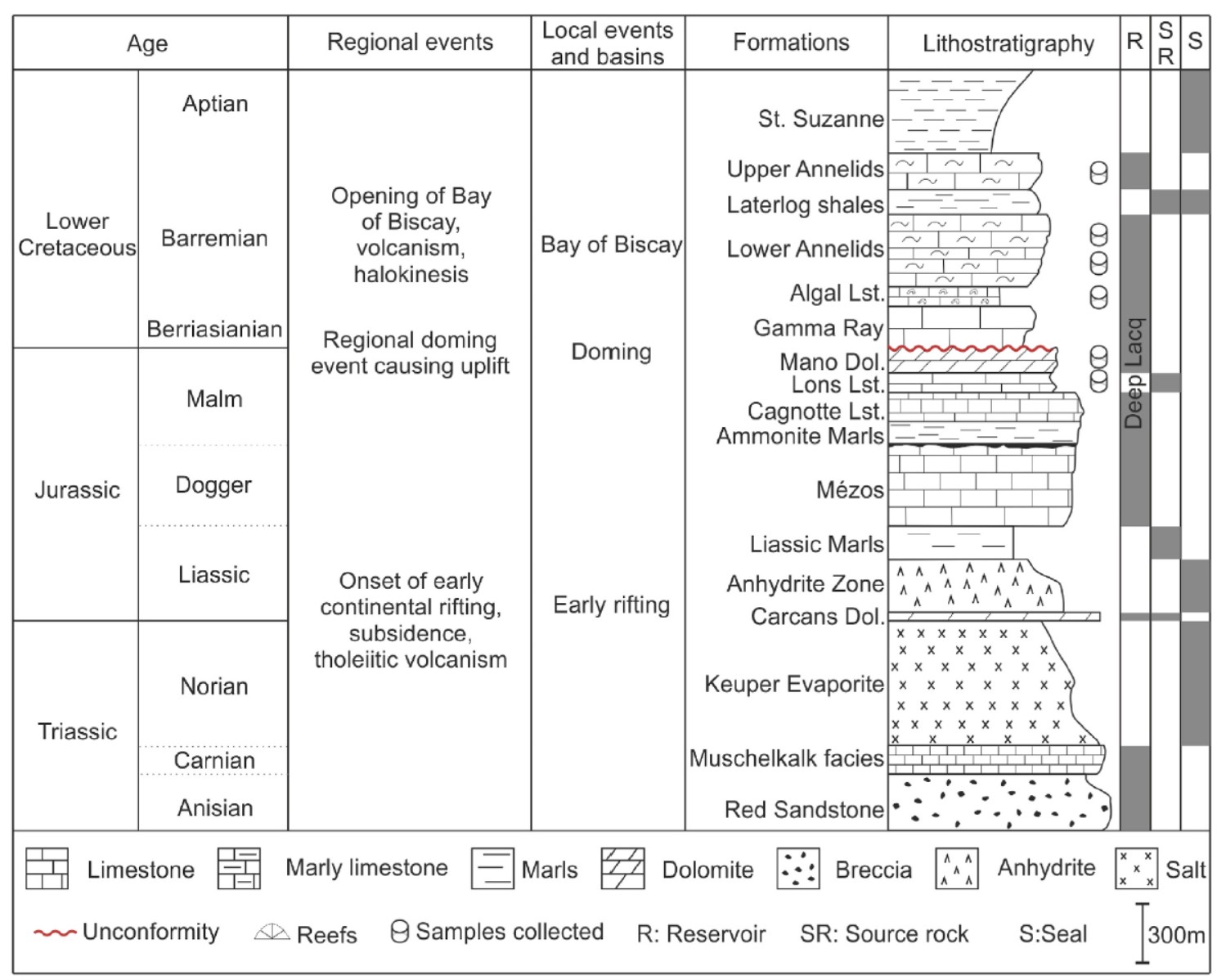
Класс Месторождения: Крупное
Тип Месторождения: Нефтегазоконденсатное
Местоположение: Суша
Местность:
Стадия разработки: В консервации
Год открытия: 1949
Источник информации:
Метод открытия:
Площадь: 74.46 км²
Lacq field
The giant Lacq field is part of the Lacq petroleum system with productive reservoirs extending over 320 km2, a gas column reaching 3100 m and reserves in the order of 8.9 trillion cubic feet (Biteau et al., 2006). The exploitation of this gas field was a pioneering achievement at the time of its discovery in 1951 The high pressure (675 bar) and temperature (1350C) with a dangerous gas composition (15,2% H2S, 9,7% CO2; 69,2% C1, 5,3% C2+) (Le-vot et al., 1996) made it necessary to build an innovative desulfurization plant in 1957, still operational till present day.
The anticlinal structure of Deep Lacq is the result of the superposition of Jurassic rifting and Early Cretaceous rifting events, later inverted during the Late Cretaceous and the Paleogene (Sibuet et al., 2004; Jammes et al, 2009, 2010; Clerc and Lagabrielle, 2014; Mouthereau et al., 2014; Corre et al., 2016; Teixell et al., 2016; Vacherat et al., 2016).
These events had significant control on the types, sources, chemistries and circulation mechanisms of the diagenetic fluids in the Aquitaine basin, as previously documented in the Rousse field (Renard et al., 2019), in the Upper Lacq oil reservoir (Elias Bahnan et al., 2020) and in the Chaînons B earnais (Incerpi et al., 2020; Motte et al., 2021; Salardon et al., 2017). However, despite its importance as the most strategic reservoir in France during the 1970s (Biteau et al., 2006), no models were yet proposed to explain the diagenesis of Deep Lacq.
This study focuses on the Kimmeridigian-Barremian Deep Lacq gas field and aims to present a diagenetic model describing the different types, sources and circulation schemes of diagenetic fluids at different phases of the complex geological history that the Aquitaine basin has experienced. The diagenetic events described in this research are placed in a geodynamic perspective that allows a better understanding of fluid activity during a complete Wilson cycle. Starting from a tectonic quiescence state and proceeding to early rifting, hyperextension, post- rift subsidence and ending with orogenesis, fluid-rock interactions are examined at each step. The case study presented in this work can be used as an example to compare diagenetic models of petroleum reservoirs in basins that experienced a similar geodynamic history as the Aquitaine.
Examples include the Dengying reservoirs of the SW Sichuan basin (Wu et al., 2016), the Jurassic carbonates of Mount Lebanon (Nader, 2003), the Mobile Bay Jurassic Norphlet Formation of the Gulf of Mexico (Mankiewicz et al., 2009), the Níspero deeply buried Lower Cretaceous carbonate reservoir in the Gulf of Mexico (Bourdet et al., 2010), the Devonian Southesk-Cairn carbonate complex in Alberta, Canada (Machel and Buschkuehle, 2008), etc … The significance of this work is the use of multi-scale modeling approaches to extrapolate μm-scale fluid inclusions to basin-scale geodynamic events of the Aquitaine basin.
The Deep Lacq reservoir is part of the Lacq petroleum system in the Arzacq sub-basin, south of the Aquitaine basin (Fig. 1).

Fig. 1 Structural map of the SW Aquitaine basin, showing the main structural elements, Cretaceous rift basins and hydrocarbon fields (modified after Biteau et al., 2006 and Elias Bahnan et al., 2020).
The Upper Lacq reservoir (Elias Bahnan et al., 2020) is separated from Deep Lacq by the Sainte Suzanne Marls. Since the target of this work is Deep Lacq, only the Jurassic to Early Cretaceous formations will be discussed.
A simplified lithostratigraphic column with the main geodynamic events is compiled in Fig. 2 The basal fluvial sandstones (Red sand-stone), limestones and dolomites (Muschelkalk) and evaporites (Keuper) constitute the Triassic formations (Fig. 2) (Lucas, 1985; Fre chengues et al., 1990; Le Marrec et al., 1995). The Carcans Dolomites is the first Jurassic formation followed by the Liassic anhydride unit (Curnelle and Dubois, 1986). The M ezos formation is a clay-rich peloidal limestone that was deposited during the mid-Jurassic (Le-Marrec et al., 1995). The Kimmeridgian is represented by the Cagnotte and Lons formations. The latter is composed of organic-rich marly limestones and dolomites and constitutes an important source rock for the Lacq petroleum system (Connan and Lacrampe-Couloume, 1993). The Late Jurassic Mano dolomite formation, an important reservoir in the Deep Lacq petroleum system, overlies the major source rock of the Lons formation (Fig. 2).

Fig. 2 Simplified stratigraphic column of the Deep Lacq reservoir, source rocks and seals. The summary of the main tectonic events is also added. (Modified from Elias Bahnan et al., 2020).
The Barremian deposits are subdivided into four formations, from bottom to top (Fig. 2): Algal Limestones, Lower Annelids Limestones, Laterlog shales, and Upper Annelids Limestone Formations (Le Marrec et al., 1995). All formations between the M ezos and the Upper Annelids (inclusive) constitute the main reservoirs of Deep Lacq (Biteau et al., 2006). Rift-related subsidence during the hyperextension created enough accommodation space for the deposition of nearly 600 m of silty marls of the Sainte-Suzanne formation, which serve as an important seal for the Deep Lacq reservoirs (Biteau et al., 2006).
Sampling
The studied core samples of Deep Lacq were obtained from wells LA-101 (Latitude: 43.420648 ; longitude: 0.619980 ) and LA-104 (Lati- tude: 43.420421 ; longitude: 0.638811 ) (Figs. 1 and 3).

Fig. 3 Interpreted seismic line passing NNE-SSW across the Lacq structure in the Arzaq basin (See Fig. 1 for location). No depth-velocity model was available to convert the TWT scale to meters. Instead, drilling reports indicate that well LA-104 (red line) reaches a true vertical depth (TVD) of 4346 m (Elias Bahnan et al.,2020). (For interpretation of the references to color in this figure legend, the reader is referred to the Web version of this article.)
Additional public data on these wells can be found at the French national geological survey website (BRGM: infoterre. brgm.fr). Following the same strategy as that described by Elias Bahnan et al. (2020) for Upper Lacq, these wells were selected after a preliminary evaluation of nearly 600 thin sections provided from the archives of TOTAL. Targeted formations include the Lons, Mano, Algal and Annelids formations (Fig. 2) and the selected samples contain abundant coarse cement phases, fractures, veins, stylolites and cross-cutting relationships observable at the macroscopic scale.
Data source: The diagenetic history of the giant Lacq gas field, witness to the apto-albian
rifting and the Pyrenean orogeny, revealed by fluid and basin modeling. 2021, Alexy Elias Bahnan, Jacques Pironon, C edric Carpentier, Guillaume Barre, Eric C. Gaucher
Следующее Месторождение: Rousse